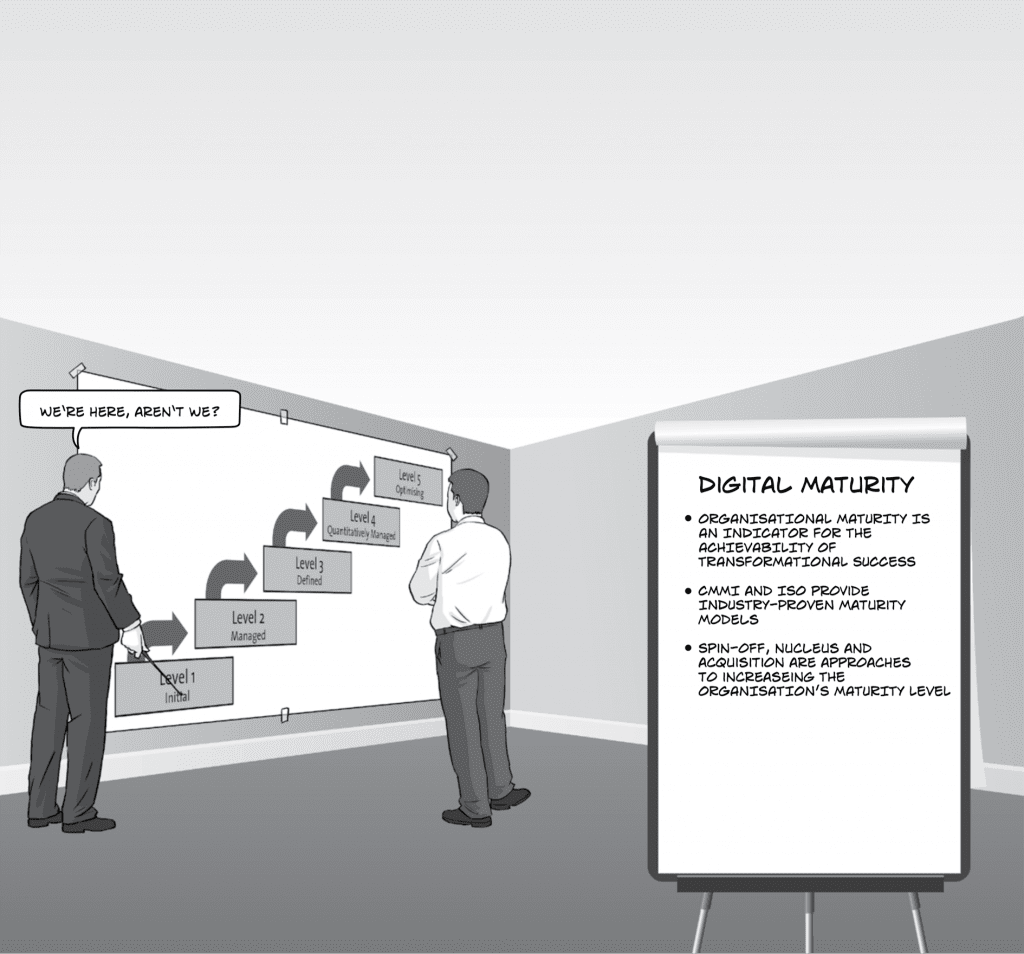Maturity models have been of interest in organisational development for many years. They accompany the development of complex organisations and maintain the capabilities necessary to fulfil an organisation’s envisaged purpose. But why exactly do enterprises need maturity models in the context of digital transformation?
Most importantly, organisational maturity serves as an indicator of the probability of the transformation’s success.
It allows management to decide on a transformation strategy, including preliminary activities to strengthen the organisation prior to digitalisation, or starting with a transformation nucleus within the company as opposed to acquiring another company that already provides the desired capabilities. In the context of theories of stage-based evolution, their basic purpose consists of describing stages and maturation paths. Based on the assumption of predictable patterns of organisational quality, maturity models represent how an organisation evolves in a stage-by-stage process along an anticipated, desired or logical path.
A well-known example of a maturity model is the CMMI (Capability Maturity Model Integration), released in 2002 by the CMMI Software Engineering Institute of the Carnegie Mellon University.[1] The focus here lies on improving an organisation’s business performance. Since Version 3, the model has offered three application-related areas of interest: acquisition (ACQ), development (DEV) and services (SVC). Another example is ISO 9000, initially released in 1987, and ISO/IEC 15504 (also known as SPICE),[2] initially released in 1998, both by the International Organization for Standardization (ISO). Other specialised models are also relevant, such as PEM (Project Execution Model) for projects or BPMM (Business Process Maturity Model) for processes. Such standards provide help to organisations who want to ensure that their products and services continuously meet customers’ requirements and that their quality is constantly improved.[3]
The standardised principles of quality management include customer focus, leadership, engagement of people, process approach, improvement, evidence-based decision-making and relationship management.[4]
The focus of this book is the well-known CMMI, with a deeper look into the CMMI-DEV model. CMMI models are tools for helping organisations to improve their way of working holistically and provide guidelines to assure a stable and capable process. For each process area defined in the model, a list of specific goals and practices is defined. It is important to note that CMMI only defines ‘what’ an effective and efficient organisation does. The model does not make any statement about the ‘how’, which every organisation must come up with according to their business principles. The maturity level represents the evolution stage of the process improvements in a predefined set of process areas. For every maturity level, the level of achievement is measured against a set of goals that apply to the respective process area.

A digital enterprise mainly operates at Level 4, characterised by well-defined processes and quantitative performance analysis, referring to the data-driven approach of digital companies. Level 4 stands in contrast to lower maturity levels, where processes are not properly defined and results are not predictable. Level 4 provides sufficient stability to automate processes.
At a higher level of maturity, Level 5 organisations exhibit very stable, self-optimising processes that are, however, not flexible enough in a fast-changing digital world.

Being digitally mature has many facets, although the characteristics of digital maturity can be postulated:
First, digital enterprises require a different form of cross-departmental cooperation. It is a characteristic of a mature organisation to exhibit the capability of accomplishing these new communication and decision flows.
Second, digital enterprises must be able to adapt swiftly to changing process requirements. On the technical side, IT interfaces and workflows are core; on the human side, interaction variability is core.
Finally, being digitally mature means not only being able to automate processes, but also doing it so that it is fully flexible. This requires a depth of understanding, a formal description and a system of measurement of the processes.
At the same time, processes must remain adaptable. In traditional processes, humans can fill in any gaps in process definitions or handle unforeseen situations. In the digital world, the situation is profoundly different.
No human interference can compensate for a deficiency by adapting behaviour, and an intelligent system must provide this compensation.
Digital enterprises need to develop their business systematically and formally by using smart processes and intelligent systems
_____
[1] Chrissis, M. B., Konrad, M., Shrum, S.: ‘CMMI for Development: Guidelines for Process Integration and Product Improvement’, 3rd ed., Addisson Wesley, 2011.
[2] Software Process Improvement and Capability Determination (SPICE) is a joint standard of ISO and the International Electrotechnical Commission (IEC).
[3] Badiru, A. B.: ‘Industry Guide to ISO 9000’, John Wiley & Sons, p. 22ff, 1995.
[4] ISO Central Secretariat: ‘Quality management principles’, International Organization for Standardization, 2015.

